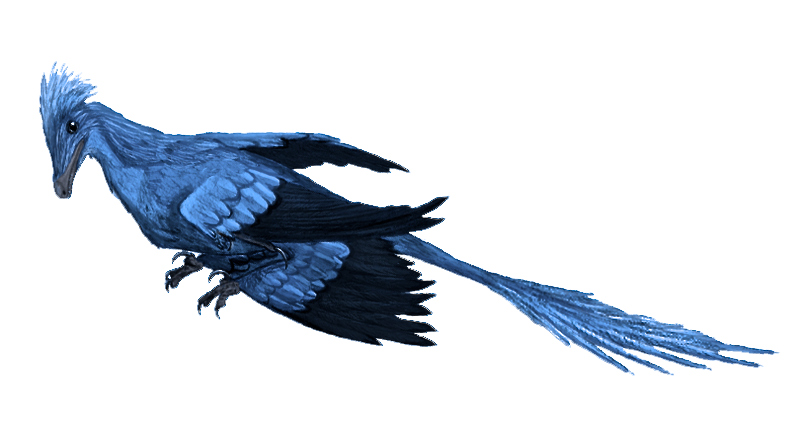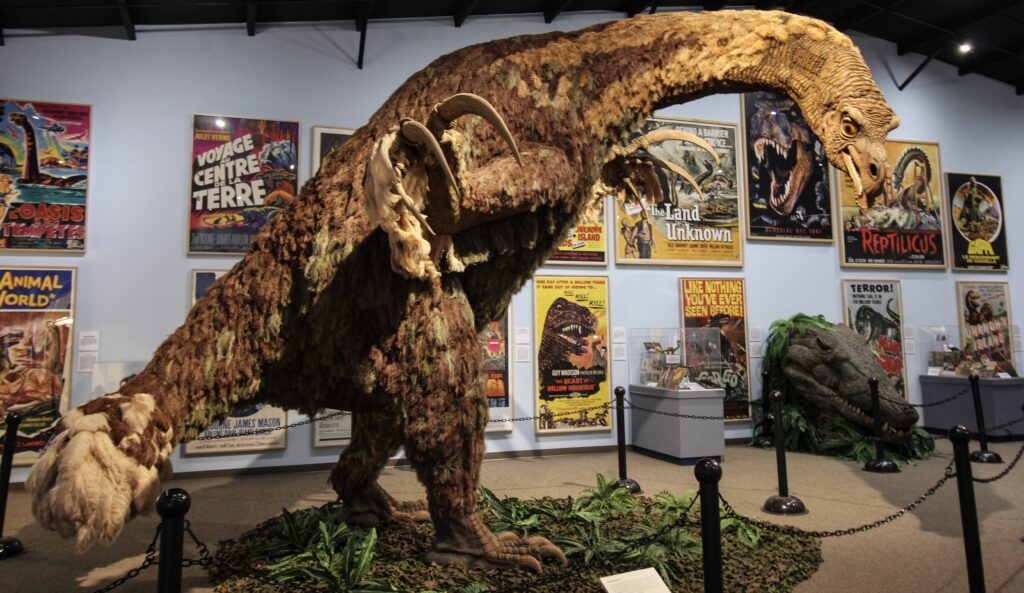Hollywood’s portrayal of dinosaurs has captivated audiences for decades, from the groundbreaking effects of “Jurassic Park” to countless B-movies featuring prehistoric beasts. While these films entertain millions, they’ve also spawned some truly outlandish theories about dinosaurs that have little to no scientific backing. These cinematic interpretations have sometimes leaked into public consciousness, creating misconceptions that paleontologists spend considerable time debunking. This article explores some of the most bizarre dinosaur theories that Hollywood has inadvertently (or sometimes deliberately) inspired, examining where these ideas originated and why actual science tells a very different story.
The Jurassic Park “Vision Based on Movement” Myth

One of the most persistent dinosaur myths comes directly from the original “Jurassic Park” film, where Dr. Alan Grant explains that Tyrannosaurus rex can’t see you if you don’t move. This dramatic plot device created intense suspense but has no basis in paleontological evidence. T. rex actually had exceptional vision, with eyes positioned for binocular sight and likely some of the best visual acuity among dinosaurs. Studies of its skull and brain cavity suggest it had large optic lobes and forward-facing eyes that would have provided excellent depth perception. The film’s creators admitted this was a creative choice for tension rather than scientific accuracy, yet the idea persists in popular culture decades later, showing how powerful Hollywood’s influence can be on public understanding of prehistoric life.
Dinosaurs as Mindless Killing Machines

Hollywood consistently portrays dinosaurs, particularly large theropods like Tyrannosaurus and Velociraptor, as single-minded killing machines bent on hunting humans. This characterization ignores the complex behaviors these animals likely exhibited as sophisticated predators in their ecosystems. Modern research indicates that many predatory dinosaurs had relatively large brain cases for their body size, suggesting intelligence comparable to modern birds and some mammals. Evidence from trackways and group fossil finds indicates social behavior in many species, while feeding patterns suggest opportunistic hunting rather than relentless pursuit. The reality is that dinosaurs were animals following natural behaviors for survival, not the movie monsters programmed for human pursuit that appear in films from “The Lost World” to “Jurassic World.”
The Myth of the Constant Roar

Perhaps no dinosaur sound is more iconic than the thunderous roar of the T. rex in “Jurassic Park,” which has influenced virtually every dinosaur depiction since. However, this dramatic vocalization is almost certainly inaccurate. Paleontologists studying the anatomy of dinosaur throats and related modern animals suggest that dinosaurs likely didn’t roar at all. Many theropods were more closely related to birds than reptiles, suggesting they might have made sounds more similar to low-frequency booms, hisses, or closed-mouth vocalizations like those of crocodilians or large birds. The film’s sound designers famously combined alligator, tiger, and elephant sounds to create the memorable T. rex roar, but this Hollywood creation has little connection to how these animals actually communicated. Some research even suggests certain dinosaurs might have had inflatable vocal sacs or crests that produced distinctive calls unlike anything in modern films.
The “Clever Girl” Syndrome: Super-Intelligent Velociraptors

Thanks to the famous “clever girl” scene in “Jurassic Park,” Velociraptors have been mythologized as having near-human intelligence, capable of complex planning, problem-solving, and even communication. This exaggeration has spawned theories about dinosaur intelligence far beyond what the fossil record supports. While Velociraptors did have a relatively high brain-to-body mass ratio compared to other dinosaurs, comparing them to primates or dolphins is a significant stretch. The actual Velociraptor was also much smaller than depicted in films – roughly turkey-sized rather than the human-sized versions on screen. Brain endocasts suggest they were likely as intelligent as modern birds of prey, which, while impressive, doesn’t translate to the strategic thinking shown in films. Additionally, the pack hunting behavior portrayed in movies, while possible, remains speculative rather than definitively proven in the fossil record for these particular dinosaurs.
The “One Meteor Killed Them All” Simplification

Hollywood disaster movies like “Dinosaur” have reinforced the oversimplified notion that dinosaurs were thriving one day and completely wiped out the next by a single meteor impact. While the Chicxulub impact was indeed catastrophic and played a major role in the extinction event, paleontological evidence indicates dinosaur diversity was already declining for millions of years before the final extinction event. Multiple factors, including massive volcanic eruptions in what is now India (the Deccan Traps), climate change, and shifting continents, had placed significant stress on dinosaur populations. Additionally, not all dinosaurs went extinct – birds are technically avian dinosaurs that survived and thrived after the extinction event. The dramatic instantaneous extinction depicted in films makes for compelling cinema but obscures the complex, gradual ecological shifts that contributed to the end of the non-avian dinosaur era over an extended timeframe.
Dinosaurs and Humans Coexisting

Movies like “One Million Years B.C.” and “The Flintstones” have perpetuated perhaps the most fundamentally incorrect dinosaur theory: that humans and dinosaurs lived together. This misconception has been so thoroughly absorbed into popular culture that polling consistently shows a significant percentage of Americans believe humans and dinosaurs coexisted. The reality involves a gap of approximately 60 million years between the extinction of non-avian dinosaurs and the emergence of humans. No human fossils have ever been found alongside dinosaur remains, despite claims from certain religious groups and cryptozoology enthusiasts. This Hollywood-reinforced misconception has serious implications for public understanding of evolutionary biology and geological time. The persistence of this myth demonstrates how entertainment media can sometimes override scientific education when presented in compelling visual formats.
All Dinosaurs Were Gigantic

Hollywood consistently gravitates toward the largest, most imposing dinosaurs, creating the impression that all dinosaurs were massive creatures. This focus on the spectacular has generated theories that dinosaurs universally grew to enormous sizes, when in reality, dinosaur species ranged dramatically in size. Many dinosaurs were no larger than modern chickens or dogs, with species like Microraptor being smaller than many modern birds. The selective representation in films ignores the tremendous diversity of the dinosaur family tree, which included thousands of species of varying sizes adapted to different ecological niches. This size diversity was actually one of the evolutionary advantages of dinosaurs, allowing them to occupy multiple environmental roles. The bias toward gigantism in films like “King Kong” and “Godzilla” (which, while not dinosaurs, influenced dinosaur portrayals) has skewed public perception toward imagining a prehistoric world filled exclusively with towering beasts.
Dinosaurs as Evolutionary Failures

A persistent narrative in dinosaur-themed disaster films portrays these creatures as evolutionary dead ends – primitive beasts that were too specialized or unintelligent to adapt to changing conditions. This fundamentally misrepresents one of the most successful animal groups in Earth’s history. Non-avian dinosaurs dominated terrestrial ecosystems for over 165 million years – far longer than humans have existed – and evolved into an astonishing variety of forms. By comparison, modern humans have existed for roughly 300,000 years. The characterization of dinosaurs as evolutionary failures ignores their remarkable adaptability across multiple climate changes and continental shifts throughout the Mesozoic Era. Moreover, their descendants – birds – continue to thrive today with over 10,000 species. Films like “Jurassic World” that portray dinosaurs as obsolete creatures that couldn’t survive without human intervention perpetuate a misunderstanding of evolutionary success that measures species solely by their current existence rather than their historical impact and longevity.
The DNA in Amber Resurrection Possibility

Perhaps the most influential dinosaur theory from Hollywood is the core premise of the “Jurassic Park” franchise – that dinosaur DNA could be extracted from mosquitoes preserved in amber and used to recreate living specimens. While brilliantly conceived for storytelling purposes, this theory has significant scientific limitations. DNA begins degrading immediately after death, and even under ideal preservation conditions, it has a half-life of approximately 521 years. This means that after about 6.8 million years, virtually no readable DNA would remain, far short of the 65+ million years since dinosaurs went extinct. While amber provides exceptional preservation for physical structures, studies of insects trapped in ancient amber have failed to yield viable DNA sequences. The complex genetic engineering depicted in the films, including filling in missing DNA with frog genes, represents a fundamental misunderstanding of genomics and species compatibility. Nevertheless, this fictional premise has inspired real research into ancient DNA extraction techniques and de-extinction efforts for more recently extinct species like passenger pigeons and woolly mammoths.
Dinosaurs as Purely Reptilian

Hollywood has traditionally depicted dinosaurs with scaly, reptilian skin, reinforcing the theory that dinosaurs were essentially oversized lizards. This representation has persisted despite mounting evidence that many dinosaurs, particularly theropods (the group including Velociraptor and T. rex), were actually feathered. Numerous fossil discoveries from China and Mongolia have revealed exquisitely preserved feather impressions on a wide variety of dinosaur species. Even larger dinosaurs that may not have had full feather coverings likely had some feathered structures, particularly when young. The persistent portrayal of dinosaurs as scaly creatures in films like “Jurassic World” (which acknowledged but then ignored this science) has hindered public acceptance of the dinosaur-bird connection. This disconnect between scientific understanding and popular media representation demonstrates how commercial considerations – the familiar reptilian appearance being more marketable – can override scientific accuracy in entertainment, leading to persistent misconceptions about dinosaur physiology.
Dinosaurs as Cold-Blooded Sluggish Reptiles

For decades, Hollywood portrayed dinosaurs as slow, lumbering creatures with reptilian metabolisms, reinforcing the theory that dinosaurs were cold-blooded like modern reptiles. This depiction, seen in early films like “The Lost World” (1925) and “Land of the Lost,” contradicts current paleontological evidence suggesting many dinosaurs were likely warm-blooded or had unique intermediate metabolisms. Evidence for higher metabolic rates comes from bone histology showing rapid growth patterns, the presence of feathers (which function as insulation), and anatomical features like hollow bones and advanced respiratory systems similar to birds. Growth rate studies indicate many dinosaurs reached maturity much faster than would be possible with a reptilian metabolism. The modern scientific consensus leans toward dinosaurs having elevated metabolic rates compared to reptiles, though perhaps not identical to modern birds or mammals. This shift in understanding dramatically changes how we visualize dinosaur behavior, suggesting more active, energetic animals than those traditionally portrayed in older films.
The Myth of the “Thunder Lizard” Translation

A peculiar misconception popularized through films and documentaries is that the word “dinosaur” translates to “terrible lizard” or “thunder lizard,” contributing to their portrayal as fearsome monsters. While “dinosaur” does derive from Greek roots meaning “terrible” or “fearfully great” (deinos) and “lizard” (sauros), this translation has been exaggerated in popular media to imply that dinosaurs were universally terrifying creatures. Sir Richard Owen, who coined the term in 1842, intended it to reflect his awe at their size and majesty rather than suggesting they were monstrous. Hollywood’s emphasis on the “terrible” aspect of the name has reinforced theories that all dinosaurs were aggressive predators, when in reality, the majority were herbivores or omnivores with complex ecological roles. This linguistic misinterpretation in films has subtly shaped public perception of these animals as inherently frightening rather than simply another fascinating branch of the evolutionary tree with diverse behaviors and adaptations.
The Dinosaur-Dragon Connection

Fantasy films and some pseudo-documentaries have proposed that ancient dragon myths originated from early human discoveries of dinosaur fossils, suggesting a direct connection between dinosaurs and mythological creatures. While this theory makes for compelling storytelling in films like “Reign of Fire,” the historical and chronological evidence doesn’t support such a straightforward relationship. Dragon myths arose independently across numerous cultures, many with features unlike any known dinosaur (multiple heads, breath weapons, magical properties). Fossil evidence indicates humans have indeed been discovering dinosaur bones for thousands of years, with some possibly inspiring certain mythological creatures in specific regions. However, Chinese dragon descriptions predated documented dinosaur fossil discoveries in that region, and European dragon myths likely drew more inspiration from living reptiles than fossils. The cinematic blending of dinosaurs and dragons has created an intriguing but largely unsupported theory about the origins of these mythical creatures, demonstrating how Hollywood can create connections between prehistoric reality and cultural mythology that become embedded in popular thinking.
Conclusion

Hollywood’s dinosaurs have certainly provided entertainment and sparked interest in paleontology, but they’ve also spawned numerous misconceptions about these fascinating prehistoric creatures. From intelligent, human-hunting Velociraptors to T. rex’s movement-based vision, these entertaining fabrications have sometimes overshadowed scientific understanding. The reality of dinosaurs – feathered, diverse in size, with complex behaviors and metabolisms – is actually more fascinating than many Hollywood portrayals. As paleontological research continues to advance, the gap between cinematic dinosaurs and their historical reality grows ever wider. Perhaps the most important lesson is that while films can inspire interest in prehistoric life, they should be viewed as entertainment rather than educational resources about how dinosaurs actually lived during their remarkable 165-million-year reign on Earth.



